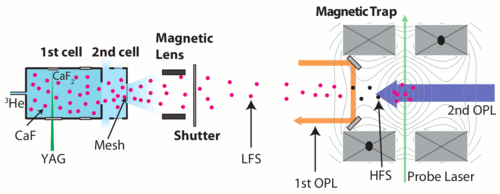Difference between revisions of "Optical Loading of Magnetic Traps"
(→Recent Publications) |
(→Recent Publications) |
||
| Line 34: | Line 34: | ||
==Recent Publications== | ==Recent Publications== | ||
| − | * [1] | + | * [1] I. Kozyryev, L. Baum, K. Matsuda, P. Olson, B. Hemmerling, and J. M. Doyle, '''Collisional relaxation of vibrational states of SrOH with He at 2 K''', [http://dx.doi.org/10.1088/1367-2630/17/4/045003 New Journal of Physics 17, 045003 (2015)]. |
* [2] H.-I Lu, I. Kozyryev, B. Hemmerling, J. Piskorski, and J. M. Doyle, '''Magnetic Trapping of Molecules via Optical Loading and Magnetic Slowing''', [http://dx.doi.org/10.1103/PhysRevLett.112.113006 Phys. Rev. Lett. 112, 113006 (2014)]. | * [2] H.-I Lu, I. Kozyryev, B. Hemmerling, J. Piskorski, and J. M. Doyle, '''Magnetic Trapping of Molecules via Optical Loading and Magnetic Slowing''', [http://dx.doi.org/10.1103/PhysRevLett.112.113006 Phys. Rev. Lett. 112, 113006 (2014)]. | ||
* [3] Hsin-I Lu, Julia Rasmussen, Matthew J. Wright, Dave Patterson, and John M. Doyle, '''Cold and Slow Molecular Beam''', [http://dx.doi.org/10.1039/c1cp21206k Phys. Chem. Chem. Phys. (2011)]. | * [3] Hsin-I Lu, Julia Rasmussen, Matthew J. Wright, Dave Patterson, and John M. Doyle, '''Cold and Slow Molecular Beam''', [http://dx.doi.org/10.1039/c1cp21206k Phys. Chem. Chem. Phys. (2011)]. | ||
* [4] D. Patterson, J. Rasmussen, and J.M. Doyle, '''Intense atomic and molecular beams via neon buffer-gas cooling''', [http://dx.doi.org/10.1088/1367-2630/11/5/055018 New Journal of Physics 11, 055018 (2009)]. | * [4] D. Patterson, J. Rasmussen, and J.M. Doyle, '''Intense atomic and molecular beams via neon buffer-gas cooling''', [http://dx.doi.org/10.1088/1367-2630/11/5/055018 New Journal of Physics 11, 055018 (2009)]. | ||
* [5] D. Patterson and J.M. Doyle, '''Bright, Guided Molecular Beam with Hydrodynamic Enhancement''', [http://dx.doi.org/10.1063/1.2717178 J. of Chem Phys 126, 154307 (2007)] | * [5] D. Patterson and J.M. Doyle, '''Bright, Guided Molecular Beam with Hydrodynamic Enhancement''', [http://dx.doi.org/10.1063/1.2717178 J. of Chem Phys 126, 154307 (2007)] | ||
Revision as of 15:39, 2 April 2015
Contents
People
Post Docs
- Boerge Hemmerling
Grad Students
- Ivan Kozyryev
- Louis Baum
Undergrad Students
- Kyle Matsuda
Former Students and Post Docs
- Hsin-I Lu
- Julia Piskorski
- Michael Casson
- Peter Olson
Overview
General approaches for delivering cold, chemically diverse molecules in large quantities could have a profound impact on research in quantum simulation [1], cold controlled chemistry [2, 3], and particle physics [4, 5]. Buffer-gas loading of polar molecules into magnetic traps has been demonstrated with many species including CaH and NH. However, increasing phase space density via evaporative or sympathetic cooling was previously inhibited by collisions with residual helium (He) buffer gas. In the current experiment, we produce a cold and slow calcium monofluoride (CaF) molecular beam with initial forward velocity around 30 m/s and load CaF (v=0, N=1) into a deep superconducting magnetic trap combining magnetic deceleration and optical pumping. A magnetic lens is used to focus low-field seeking states. Irreversible trap loading is achieved using two optical pumping stages, where scattered photons remove molecular potential energy and entropy. Using a cryogenic shutter to block the buffer gas after trap loading, we observe a trap lifetime exceeding 500 ms, limited by background He collisions. Since the trap loading scheme requires scattering of only a few photons, the method is applicable to a wide range of magnetic species, including polyatomic molecules.
Currently, we are pursuing co-trapping of calcium monohydride (CaH) molecules with lithium (Li) atoms for studying Li-CaH collisions. We have already produced a slow beam of CaH [6] and previous theoretical work [7] predicts good collisional properties for the chosen atom-molecule pair. Moreover, since CaH has a larger rotational constant than CaF, we are able to operate our trap at its maximum capacity.
In parallel, we are also working toward the optical loading and magnetic trapping of small polyatomic molecules. We have already buffer-gas cooled SrOH and studied its inelastic collisions with He. The electronic structure of this triatomic molecule is similar to that of CaF and SrF. Moreover, optical pumping and detection of SrOH in our experiment can be performed with all solid-state diode lasers. We are planning on co-trapping of SrOH and K for studying atom-molecule collisions and exploring the possibility of sympathetic cooling for polyatomic molecules.
- [1] Micheli et al., Nature Physics 2, 341 (2006).
- [2] Ospelkaus et al., Science 327, 853 (2010).
- [3] De Miranda et al., Nature Physics 7, 502 (2011).
- [4] Hudson et al., Nature 473, 493 (2011).
- [5] Baron et al., Science 343, 269 (2014).
- [6] Lu et al., Phys. Chem. Chem. Phys. 13, 42 (2011).
- [7] Tscherbul et al., Phys. Rev. A 84, 4 (2011).
Recent Publications
- [1] I. Kozyryev, L. Baum, K. Matsuda, P. Olson, B. Hemmerling, and J. M. Doyle, Collisional relaxation of vibrational states of SrOH with He at 2 K, New Journal of Physics 17, 045003 (2015).
- [2] H.-I Lu, I. Kozyryev, B. Hemmerling, J. Piskorski, and J. M. Doyle, Magnetic Trapping of Molecules via Optical Loading and Magnetic Slowing, Phys. Rev. Lett. 112, 113006 (2014).
- [3] Hsin-I Lu, Julia Rasmussen, Matthew J. Wright, Dave Patterson, and John M. Doyle, Cold and Slow Molecular Beam, Phys. Chem. Chem. Phys. (2011).
- [4] D. Patterson, J. Rasmussen, and J.M. Doyle, Intense atomic and molecular beams via neon buffer-gas cooling, New Journal of Physics 11, 055018 (2009).
- [5] D. Patterson and J.M. Doyle, Bright, Guided Molecular Beam with Hydrodynamic Enhancement, J. of Chem Phys 126, 154307 (2007)
